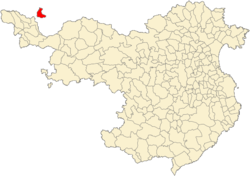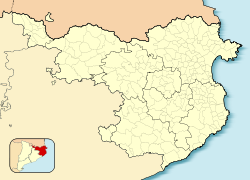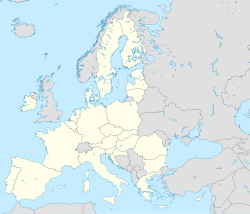Llívia
| Llívia | ||
|---|---|---|
| Municipality | ||
 |
||
|
||
 Location of Llívia in the province of Girona |
||
| Location in Catalonia | ||
| Coordinates: 42°27′52″N 1°58′51″E / 42.46444°N 1.98083°ECoordinates: 42°27′52″N 1°58′51″E / 42.46444°N 1.98083°E | ||
| Country |
|
|
| Autonomous community |
|
|
| Province | Girona | |
| Comarca | Cerdanya | |
| Judicial district | Puigcerdà | |
| Government | ||
| • Mayor | Elies Nova Inglés (2015) | |
| Area | ||
| • Total | 12.9 km2 (5.0 sq mi) | |
| Elevation | 1,224 m (4,016 ft) | |
| Population (2014) | ||
| • Total | 1,536 | |
| • Density | 120/km2 (310/sq mi) | |
| Demonym(s) | Llivienses | |
| Time zone | CET (UTC+1) | |
| • Summer (DST) | CEST (UTC+2) | |
| Postal code | 17527 | |
| Website | www |
|
Llívia (Catalan pronunciation: [ˈʎiβiə]) is a town in the comarca of Cerdanya, province of Girona, Catalonia, Spain. It is a Spanish exclave within the French département of Pyrénées-Orientales. In 2009, the municipality of Llívia had a total population of 1,589. It is separated from the rest of Spain by a corridor about 1.6 km (1.0 mile) wide, which includes the French communes of Ur and Bourg-Madame.
The Esteve Pharmacy, which is now located in Llívia's recently revamped municipal museum, is a complete 18th-century pharmacy donated to the town by the family who owned it, on condition the contents remain in the town. There are records of pharmacists practising in Llívia since medieval times. The pharmacy has a large display of albarelli, a type of ceramic jar used in pharmacies, as well as antique drugs, and one of the most important collections of prescription books in Europe.
Llívia was the site of an Iberian oppidum which commanded the region and was named Julia Lybica by the Romans. It was the ancient capital of Cerdanya in antiquity, before being replaced by Hix (commune of Bourg-Madame, France) in the Middle Ages. During the Visigothic period, its citadel, the castrum Libiae, was held by the rebel Paul of Narbonne against King Wamba in 672. As the "town (or 'city') of Cerdanya," 8th century Llívia may also have been the scene of the siege by which governor Abdul Rahman Al Ghafiqi of Muslim Spain rid himself of the Moorish (Berber) rebel Uthman ibn Naissa ("Munnuza"), who had allied himself with Duke Eudo of Aquitaine to improve the chances of his rebellion, ahead of the Battle of Tours (732 or 733), also known as the Battle of Poitiers.
...
Wikipedia





